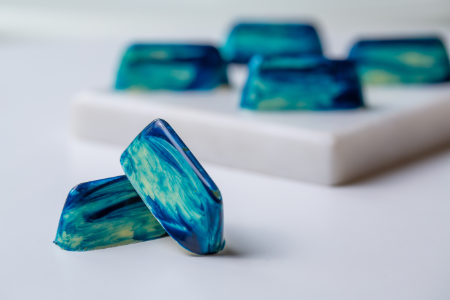
Lapis lazuli, or lapis for short, is a deep-blue metamorphic rock. It is used as a semi-precious stone. It has been prized since antiquity for its intense color. The name comes from the Persian word for the gem, lāžward. Lapis lazuli is a rock composed primarily of lazurite, pyrite, and calcite. As early as the 7th millennium BC, people mined lapis lazuli in the Sar-i Sang mines and in Shortugai. It was also mined in other mines in Badakhshan province in modern northeast Afghanistan. Lapis lazuli artifacts are dated to 7570 BC. They have been found at Bhirrana, which is the oldest site of Indus Valley civilisation. Lapis was highly valued by the Indus Valley Civilisation (3300–1900 BC). Lapis beads have been found at Neolithic burials in Mehrgarh, the Caucasus, and as far away as Mauritania. It was used in the funeral mask of Tutankhamun (1341–1323 BC).
Lapis lazuli has been used since ancient times and remains popular today. This gemstone has been prized for its bright, blue color. It is used for inlay and intarsia. It is also used for pigments for cosmetics and paintings. Its eye appeal is irresistible. Today, jewelry is its predominant use.

Lapis lazuli value is determined almost exclusively by color. A deep, intense, blue with violet tones would be at the apex. Fine grained, uniform specimens can attain a smooth, highly polished surface not seen in lower grades.
Calcite inclusions almost always lower the value. Pyrite inclusions enhance it in the minds of many collectors and jewelry lovers. Although enthusiasts may debate how much pyrite is ideal in lapis lazuli, most would agree on one thing. The stone is better with less calcite. Calcite can appear as streaks or patches within the darker blue. It can also predominate in the mix, giving the rock an overall lighter blue shade.
Polish quality and faceting artistry also affect value.
The ancient Roman natural historian Pliny the Elder admired lapis lazuli for its colors. He called it “a fragment of the starry firmament,” because it is deep blue with twinkling bits of gold. Lapis lazuli (also simply referred to as lapis) is actually a rock. It is composed of lazurite, haüyne, sodalite, and nosean. These are all members of the sodalite group of minerals. (Lazurite itself may be considered a sulfur-rich haüyne).

Archeologists have found lapis lazuli beads, jewelry, and carvings at numerous sites, some dating as early as 6,000 BCE. The use of this gem material for art and jewelry probably originated in Afghanistan. It spread to Asia, the Middle East, the Mediterranean, and the Roman world. In the Latin-speaking world of classical antiquity, many gemstones called sapphire or sapphirus may have been pieces of lapis. These names mean “blue stone.” In classical antiquity’s Latin-speaking world, many gemstones called sapphire or sapphirus may have been pieces of lapis. These names mean “blue stone
By the end of the Middle Ages, lapis lazuli began to be exported to Europe. It was ground into powder. The powder was made into the pigment ultramarine. Ultramarine was used by some of the most important artists of the Renaissance and Baroque. These artists include Masaccio, Perugino, Titian, and Vermeer. Ultramarine was often reserved for the clothing of the central figures of their paintings. This was especially true for the Virgin Mary. Ultramarine has also been found in dental tartar of medieval nuns and scribes. This might have been due to them licking their painting brushes while producing medieval texts. It was common when working on manuscripts.
Lapis lazuli usually occurs in crystalline marble as a result of contact metamorphism.

Lapis takes an excellent polish and can be made into jewellery, carvings, boxes, mosaics, ornaments, small statues, and vases. Interior items and finishing buildings can be also made with lapis. During the Renaissance, lapis was ground and processed to make the pigment ultramarine for use in frescoes and oil painting. Its usage as a pigment in oil paint largely ended during the early 19th century. This change occurred when a chemically identical synthetic variety became available.
Lapis lazuli is commercially synthesized or simulated by the Gillson process. This process is used to make artificial ultramarine and hydrous zinc phosphates. Spinel or sodalite, or dyed jasper or howlite, can be substituted for lapis. (1)
Sources
(1) Wikipedia
(2) Photos by Freepik
In My Shop
Multicolor Lapis Lazuli Bracelets
These Multicolor Lapis Lazuli Bracelets are composed of 8mm Natural Multicolor Lapis Lazuli Beads and elastic cord


